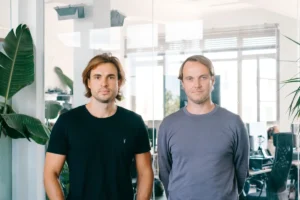
Terra One, a Berlin-based startup powering the transition to green energy with its grid-connected large-scale battery storage systems, has raised $7.5 million in seed funding. Leading the round is PT1, the early-stage VC for transformative real asset technologies, with the support of neosfer, the early-stage investor of Commerzbank. 468 Capital, the first backers of Terra One, also participated, alongside N26 co-founder Maximilian Tayenthal, serial entrepreneur Jan Beckers, and the scout funds of Andreessen Horowitz and Hedosophia. The company will use the funding to build out its team, further develop its AI battery optimisation software and extend its project pipeline.
Co-founded by serial entrepreneur Tony Schumacher and Thomas Antonioli, the former CFO of sharing economy startup Grover, whose clever approach to renting technology helped it become a billion dollar unicorn, Terra One is aiming to help Europe achieve its climate goals and wean the continent off politically sensitive and non-renewable energy sources.
While solar capacity is expanding and more wind turbines are being installed, the current electricity grid and storage capacities are inadequate, which prevents a full transition to renewable energy. In 2022, for example, Germany lost eight terawatt hours of energy (enough to power four million households) because of inefficient grid management and congestion. Without action, the numbers will increase in the medium term as more renewables come online.
Terra One aims to solve the challenge through its network of decentralised battery storage projects, which charge when the proportion of renewable energy sitting in the grid is typically at its highest (during the day or at night when people are not making their breakfast or dinner) and the prices for electricity are at their lowest. The units discharge when the grid would otherwise have to switch to conventional power generation and prices are therefore significantly higher.
This reduces costs and makes sure no energy produced by renewable sources is lost. Terra One’s own AI foundation model has been optimised for energy market trading (with producers on one side and large energy vendors on other side) so it automatically charges and discharges in line with demand, production and time.
Not only will its intelligent AI trading tool generate attractive returns, without subsidies, but at the same time the company’s storage capacity will relieve grid congestion – a major hurdle to overcome which will help the world reach 100 per cent green energy.
Its current largest approved battery projects can power a city of 100,000 people for up to six hours and it has built up a pipeline of 300 projects with more than 20 Gigawatt hours (GWh). For context, it takes 67,200 gallons of oil to produce just one Gwh of electricity. One Gigawatt of energy can power 100 million LED light bulbs and is equivalent to almost 2.5 million solar panels.
Terra One has secured nearly 300 sites to build storage facilities, positioning it as one of Europe’s largest storage operators. The company finances these projects through institutional and infrastructure investors attracted by promising potential returns and strong ESG credentials.
Terra One co-founder, Thomas Antonioli, said:“We are very excited about this financing round, which will allow us to drive forward our vision of building Europe’s leading battery optimiser and thus make an essential contribution to achieving climate targets. Specifically, we will use the financing to further build our team and develop our revolutionary battery optimisation software and our project pipeline.”
Terra One co-founder, Tony Schumacher, said:“People outside the energy industry often have little idea of how much energy our projects can store. Our current largest approved battery projects can power a city of 100,000 people for up to six hours. That’s a huge capacity that makes it possible to compensate for fluctuations in renewable energy production on a large scale. We are building important infrastructure to enable the energy transition.”